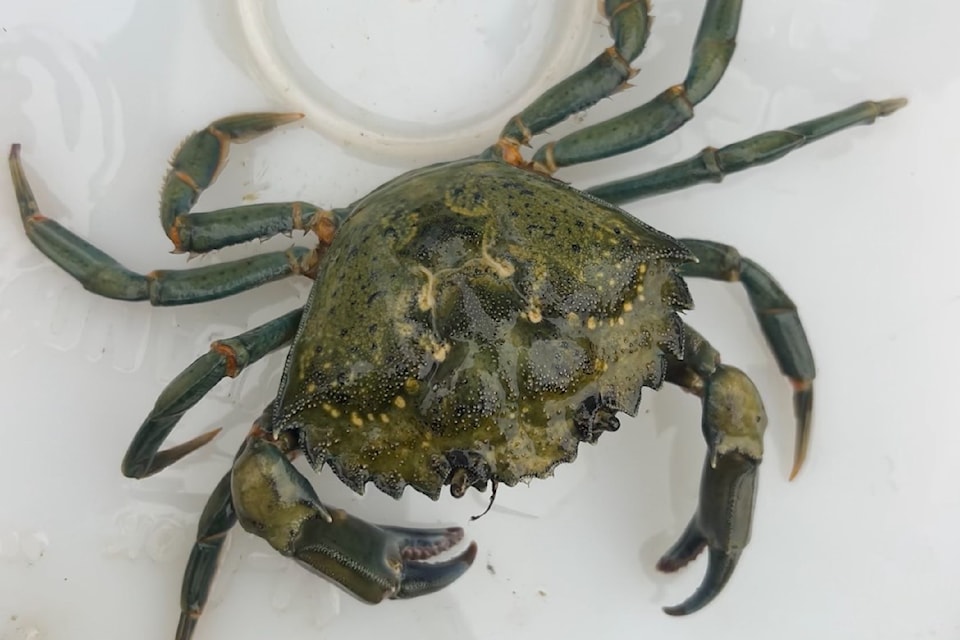The invasive European green crabs are on the B.C. coast, and experts with the Fisheries and Oceans Canada are warning that it's vital to report the species if spotted – before it's too late.
Christine Spice, aquatic invasive species biologist with the DFO, presented to the Gabriola Island Shorekeepers last month about the introduced threat.
Spice told Black Pres Media hat the main message she wants to get out is that while these invasive crabs are here, they have not yet established in the Salish Sea, and humans still have a chance to prevent that outcome – but the community's role in reporting potential sightings is crucial.
"European green crab are aggressive invaders and voracious predators," Spice said. "They prey on native shore crabs, shellfish, intertidal fish and invertebrates competing with native species – including juvenile Dungeness crabs – for food and shelter. This poses a threat to both ecologically and commercially important marine populations."
The crabs, native to Europe and North Africa, were accidentally introduced to the United States in late 1980s. From there, Spice said Fisheries and Oceans Canada believes that the larvae likely travelled north along the West Coast. They were first detected on the west coast of Vancouver Island in 1998, with first detections at Witty’s Lagoon on the south Island in 2018, Port Hardy in 2019 and Esquimalt Lagoon in 2022.
In 2024, European green crab DNA was first detected at the Descanso Bay in a light trap during the first full season of the fisheries department's eDNA monitoring project. The eDNA indicated that the crab's larvae has reached Gabriola Island, James Island off Saanich and the Sunshine Coast.
"Smaller, localized populations exist on the northeast coast of Vancouver Island and in the Victoria area," Spice said. "Since 2018, European green grabs have been detected in the Salish Sea in very low numbers – but they are not yet considered established there and Fisheries and Oceans Canada along with partners have been removing detected populations."
She warned it's likely the species is reaching even more of the region that what is known. Females can produce up to 185,000 eggs twice a year.
"As adjacent populations, like those on the west coast of Vancouver Island, grow larger, more European green crab larvae are released into ocean currents that can carry them into the Salish Sea. This increases the risk of European green crabs becoming established here."
Spice said the best way to identify the species is by the five spines on each side of the eyes, also called 'marginal teeth.' Unlike what the name would suggest, colour is not a reliable method of identification.
Public education is a key part of the department's prevention and early detection effort, according to Spice, along with rapid response to sightings and long-term management and control.
The Gabriola Island Shorekeepers, who hosted the talk about the invasive crabs, are a group of volunteers who promote, maintain, and monitor the health of Gabriola Island ecosystems, including beaches, bluffs, estuaries. Isobel Pearsall, executive committee member, said the group wants to educate members of the public on important issues and let them know how they can make a difference and get involved.
"The green crab pose such a threat to our natural ecosystems…" she said. "Hopefully people will be looking under rocks and it gets more eyes on the shoreline and then we have a bit of an early warning system in place."
Pearsall drew attention to the local abundance of eelgrass, which could be at risk if the crabs spread.
"Eelgrass is an important nursery habitat for a lot of things, including juvenile salmon and herring, so folks here want to understand if there are threats, what can you do and who should we let know if there's a green crab that's potentially going to threaten those habitats."
If someone sees what they believe to be a European green crab, Fisheries and Oceans Canada advises taking photos and contacting the department to report the GPS coordinates, observation date and identifying features. Most importantly, the crabs should not be returned to the water.
The department can be contacted toll-free at 1-888-356-7525 or through e-mail at dfo.aispacific-eaepacifique.mpo@dfo-mpo.gc.ca.



